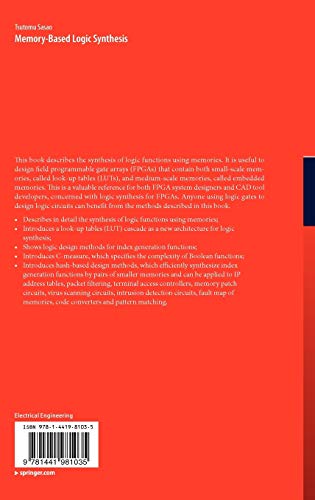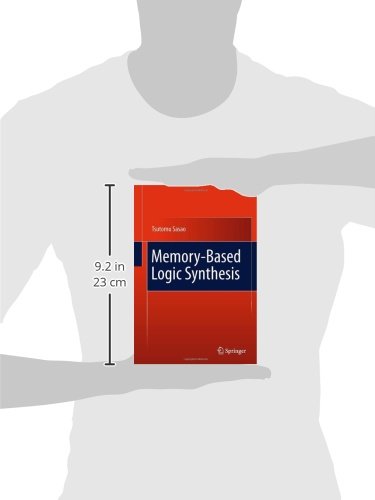Memory-Based Logic Synthesis
₱11,412.00
Product Description
This book describes the synthesis of logic functions using memories. It is useful to design field programmable gate arrays (FPGAs) that contain both small-scale memories, called look-up tables (LUTs), and medium-scale memories, called embedded memories. This is a valuable reference for both FPGA system designers and CAD tool developers, concerned with logic synthesis for FPGAs.
From the Author
Chapter 1 Introduction
1.1 Motivation
1.2 Organization of the Book
Chapter 2 Basic Elements
2.1 Memory
2.2 Programmable Logic Array (PLA)
2.3 Content Addressable Memory (CAM)
2.4 Field Programmable Gate Array (FPGA)
2.5 Remarks and Problems
Chapter 3 Definitions and Basic Properties
3.1 Functions
3.2 Logical Expression
3.3 Functional Decomposition
3.4 Binary Decision Diagram
3.5 Symmetric Functions
3.6 Technology Mapping
3.7 The Mathematical Constant $e$ and Its Property
3.8 Remarks and Problems
Chapter 4 MUX-Based Synthesis
4.1 Fundamentals of MUX
4.2 MUX-based Realization
4.3 Remarks and Problems
Chapter 5 Cascade-Based Synthesis
5.1 Functional Decomposition and LUT Cascade
5.2 Number of LUTs to Realize General Functions
5.3 Number of LUTs to Realize Symmetric Functions
5.4 Remarks and Problems
Chapter 6 Encoding Method
6.1 Decomposition and Equivalence Class
6.2 Disjoint Encoding
6.3 Non-disjoint Encoding
6.4 Remarks and Problems
Chapter 7 Functions with Small C-Measures
7.1 C-measure and BDDs
7.2 Symmetric Functions
7.3 Sparse Functions
7.4 LPM Functions
7.5 Segment Index Encoder Function
7.6 WS Functions
7.7 Modulo Function
7.8 Remarks and Problems
Chapter 8 C-Measure of Sparse Functions
8.1 Logic Functions with Specified Weights
8.2 Uniformly Distributed Functions
8.3 Experimental Results
8.4 Remarks and Problems
Chapter 9 Index Generation Functions
9.1 Index Generation Functions and Their Realizations
9.2 Address Table
9.3 Terminal Access Controller
9.4 Memory Patch Circuit
9.5 Periodic Table of the Chemical Elements
9.6 English-Japanese Dictionary
9.7 Properties of Index Generation Functions
9.8 Realization using (p,q)-elements
9.9 Realization of Logic Functions with Weight $k$
9.10 Remarks and Problems
Chapter 10 Hash-Based Synthesis
10.1 Hash Function
10.2 Index Generation Unit (IGU)
10.3 Reduction by a Linear Transformation
10.4 Hybrid Method
10.5 Registered Vectors Realized by Main Memory
10.6 Super Hybrid Method
10.7 Parallel Sieve Method
10.8 Experimental Results
10.9 Remarks and Problems
Chapter 11 Reduction of the Number of Variables
11.1 Optimization for Incompletely Specified Functions
11.2 Definitions and Basic Properties
11.3 Algorithm to Minimize the Number of Variables
11.4 Analysis for Single-Output Logic Functions
11.5 Extension to Multiple-Output Functions
11.6 Experimental Results
11.7 Remarks and Problems
Chapter 12 Various Realizations
12.1 Realization using Registers, Gates, and an Encoder
12.2 LUT Cascade Emulator
12.3 Realization using Cascade and AUX Memory
12.4 Comparison of Various Methods
12.5 Code Converter
12.6 Remarks and Problems
Chapter 13 Conclusions
Solutions to the Problems.
From the Back Cover
This book describes the synthesis of logic functions using memories. It is useful to design field programmable gate arrays (FPGAs) that contain both small-scale memories, called look-up tables (LU












